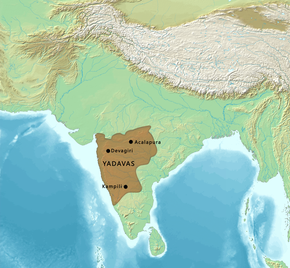
Back سلالة سيونا (يادافا) Arabic সেউণ (যাদব) রাজবংশ Bengali/Bangla Dinastia Seuna Catalan Seuna-Dynastie German Dinastía Seuna Spanish دودمان سئونا (یداوا) Persian देवगिरि के यादव Hindi Seuna Italian ヤーダヴァ朝 Japanese ಸೇವುಣ Kannada
Seuna (Yadava) dynasty | |||||||||||
|---|---|---|---|---|---|---|---|---|---|---|---|
| c. 1187[1]–1317 | |||||||||||
Flag of the Yadavas according to the Catalan Atlas
Coinage of Yadavas of Devagiri, king Bhillama V (1185-1193). Central lotus blossom, two shri signs, elephant, conch, and “[Bhilla]/madeva” in Devanagari above arrow right
| |||||||||||
Territory of the Yadavas and neighbouring polities, circa 1200-1300 CE.[2] | |||||||||||
| Capital | Devagiri | ||||||||||
| Common languages | Kannada Sanskrit Marathi | ||||||||||
| Religion | Hinduism | ||||||||||
| Government | Monarchy | ||||||||||
| History | |||||||||||
• Earliest rulers | c. 860 | ||||||||||
• Established | c. 1187[1] | ||||||||||
• Disestablished | 1317 | ||||||||||
| |||||||||||
| Today part of | India | ||||||||||
The Seuna, Sevuna, or Yadavas of Devagiri (IAST: Seuṇa, c. 1187–1317)[3] was a medieval Indian dynasty, which at its peak ruled a realm stretching from the Narmada river in the north to the Tungabhadra river in the south, in the western part of the Deccan region. Its territory included present-day Maharashtra, northern Karnataka and parts of Madhya Pradesh, from its capital at Devagiri (present-day Daulatabad in modern Chhatrapati Sambhajinagar district, Maharashtra).
The Yadavas initially ruled as feudatories of the Western Chalukyas. Around the middle of the 12th century, as the Chalukya power waned, the Yadava king Bhillama V declared independence. The Yadavas reached their peak under Simhana II, and flourished until the early 14th century, when it was annexed by the Khalji dynasty of the Delhi Sultanate in 1308 CE.
- ^ A. S. Altekar 1960, p. 524.
- ^ Schwartzberg, Joseph E. (1978). A Historical atlas of South Asia. Chicago: University of Chicago Press. p. 147, map XIV.3 (c). ISBN 0226742210.
- ^ T. V. Mahalingam 1957, p. 137.



